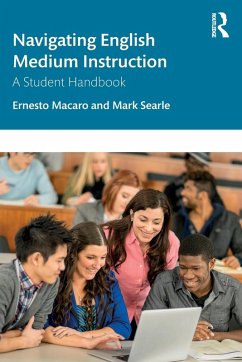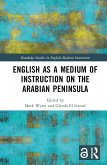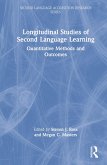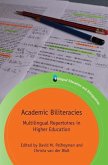- Broschiertes Buch
- Merkliste
- Auf die Merkliste
- Bewerten Bewerten
- Teilen
- Produkt teilen
- Produkterinnerung
- Produkterinnerung
This skills-oriented handbook for English Medium Instruction (EMI) learners provides students with a toolbox of strategies and approaches to maximize their performance in their courses. This is a valuable resource for any EMI student across the world, EMI teachers, EAP/ESP educators, and academic support staff.
Andere Kunden interessierten sich auch für
![English as a Medium of Instruction on the Arabian Peninsula English as a Medium of Instruction on the Arabian Peninsula]() English as a Medium of Instruction on the Arabian Peninsula177,99 €
English as a Medium of Instruction on the Arabian Peninsula177,99 €![Longitudinal Studies of Second Language Learning Longitudinal Studies of Second Language Learning]() Longitudinal Studies of Second Language Learning174,99 €
Longitudinal Studies of Second Language Learning174,99 €![Academic Biliteracies Academic Biliteracies]() Academic Biliteracies161,99 €
Academic Biliteracies161,99 €![Corpus Linguistics and Second Language Acquisition Corpus Linguistics and Second Language Acquisition]() Xiaofei LuCorpus Linguistics and Second Language Acquisition176,99 €
Xiaofei LuCorpus Linguistics and Second Language Acquisition176,99 €![Englisch lernen für Anfänger: Mit dem genialen Sprachkurs in kürzester Zeit englisch lesen, schreiben und akzentfrei reden wie ein Einheimischer Englisch lernen für Anfänger: Mit dem genialen Sprachkurs in kürzester Zeit englisch lesen, schreiben und akzentfrei reden wie ein Einheimischer]() Elisabeth RobertsEnglisch lernen für Anfänger: Mit dem genialen Sprachkurs in kürzester Zeit englisch lesen, schreiben und akzentfrei reden wie ein Einheimischer15,90 €
Elisabeth RobertsEnglisch lernen für Anfänger: Mit dem genialen Sprachkurs in kürzester Zeit englisch lesen, schreiben und akzentfrei reden wie ein Einheimischer15,90 €![Exploring Vocabulary Exploring Vocabulary]() Dee GardnerExploring Vocabulary196,99 €
Dee GardnerExploring Vocabulary196,99 €![L2 Selves and Motivations in Asian Contexts L2 Selves and Motivations in Asian Contexts]() L2 Selves and Motivations in Asian Contexts172,99 €
L2 Selves and Motivations in Asian Contexts172,99 €-
-
-
This skills-oriented handbook for English Medium Instruction (EMI) learners provides students with a toolbox of strategies and approaches to maximize their performance in their courses. This is a valuable resource for any EMI student across the world, EMI teachers, EAP/ESP educators, and academic support staff.
Hinweis: Dieser Artikel kann nur an eine deutsche Lieferadresse ausgeliefert werden.
Hinweis: Dieser Artikel kann nur an eine deutsche Lieferadresse ausgeliefert werden.
Produktdetails
- Produktdetails
- Verlag: Taylor & Francis Ltd
- Seitenzahl: 124
- Erscheinungstermin: 28. Februar 2025
- Englisch
- Abmessung: 229mm x 152mm
- ISBN-13: 9781032892986
- ISBN-10: 1032892986
- Artikelnr.: 71779185
- Herstellerkennzeichnung
- Libri GmbH
- Europaallee 1
- 36244 Bad Hersfeld
- gpsr@libri.de
- Verlag: Taylor & Francis Ltd
- Seitenzahl: 124
- Erscheinungstermin: 28. Februar 2025
- Englisch
- Abmessung: 229mm x 152mm
- ISBN-13: 9781032892986
- ISBN-10: 1032892986
- Artikelnr.: 71779185
- Herstellerkennzeichnung
- Libri GmbH
- Europaallee 1
- 36244 Bad Hersfeld
- gpsr@libri.de
Ernesto Macaro is Emeritus Professor of Applied Linguistics at the University of Oxford. Before becoming a teacher educator and researcher in language learning he was a language teacher for 16 years. His research has focused on second language learning strategies and on the interaction between teachers and learners. He now applies these foci to classrooms where academic content is being taught through English. Mark Searle is an Honorary Norham Fellow, Associate of the EMI Research Group and previously was a Lecturer in ELT in the University of Oxford Department of Education. For many years he was a senior consultant teacher trainer for the British Council, designing and delivering teacher training courses in EAP and EMI in universities worldwide. This experience has given him considerable insight into the needs of EMI teachers and learners in many different contexts. He has also co-designed and co-delivered EMI teacher training courses with Ernesto Macaro both in the Department of Education and abroad.
Contents
Some reactions of students from Sri Lanka and from Hong Kong
Acknowledgments
Chapter 1 : INTRODUCTORY SECTIONS
1.1a How to Work with This Book
1.1b A General Glossary of Terms Used in This Book (How We Have Used
Certain Words)
1.2 Your Transition from School to University
1.3 Let's 'Situate' Your EMI Subject
1.4 What Are Your EMI Lessons Like?
1.5 Your 'Language Support' Programme
1.6 Dealing with Words: Technical Words; Technical-Plus Words; General
Academic Words; Everyday Words
Chapter 2 : AROUND YOUR CLASSES: BEFORE TAKING OFF!
2.1 Strategies for You to Consider Just Before the Lesson
2.2 Technical and Academic Words in a Text
2.3 What Do We Mean By 'Keywords'? (Dealing With 'The Concept Iceberg')
2.4 Before the Lecture: Getting Ready!
2.5 Using the Lecture Title and Course Outline to Prepare
2.6 Knowing Your Lecturer's Voice aand Language
2.7 Online Lectures and Podcasts
2.8 Preparing to Listen to Your Teacher: Using Audio Recordings
2.9 Pre-Lecture Reading: Your Own Reasons for Reading
2.10 Pre-Reading Around Your Classes
Chapter 3 : IN-FLIGHT STRATEGIES: COPING WITH TURBULENCE
3.1 Note-Taking: What Goes on in Our Brains!
3.2 Making In-flight Lecture Notes
3.3 Strategies to Think About During the Lesson
3.4 Discourse Markers: Navigating a Lecture
3.5 The Prior Knowledge Strategy When Listening
3.6 The IRF Sequence: What It Is For; What It Does; How to Deal with It.
3.7 You and Your Home Language: To Use Or Not To Use, That Is The Question!
3.8 Language Demands of Notes
Chapter 4 : AROUND YOUR CLASSES: REFLECTING AFTER LANDING
4.1 Improving Your Note-Taking Together
4.2 The Power of Talking
4.3 Work with Course-Mates: From Notes to Connected Speech
4.4 Accountable Talk: Making It All a Little More Formal
4.5 Multiword Units
4.6 Word Families
4.7 Gently Persuading Your Teacher
4.8 Elaborate Interrogation: How/Why?
4.9 Guided Reciprocal Peer Questioning: The Power of Questions and Answers!
4.10 Reflecting on Questions Post-Lesson
4.11 Examples of Socratic Questions: Invitations to Better Thinking
4.12 Ideas for Better Answers
4.13 Developing Your Range of Rhetorical Functions
4.14 Working on Your Own with Your Smartphone
4.15 Modified Cornell Notes: From In-Flight Note-Taking to Post-Flight
Note-Making
4.16 Post-Class Reading For Writing
4.17 Writing
Some reactions of students from Sri Lanka and from Hong Kong
Acknowledgments
Chapter 1 : INTRODUCTORY SECTIONS
1.1a How to Work with This Book
1.1b A General Glossary of Terms Used in This Book (How We Have Used
Certain Words)
1.2 Your Transition from School to University
1.3 Let's 'Situate' Your EMI Subject
1.4 What Are Your EMI Lessons Like?
1.5 Your 'Language Support' Programme
1.6 Dealing with Words: Technical Words; Technical-Plus Words; General
Academic Words; Everyday Words
Chapter 2 : AROUND YOUR CLASSES: BEFORE TAKING OFF!
2.1 Strategies for You to Consider Just Before the Lesson
2.2 Technical and Academic Words in a Text
2.3 What Do We Mean By 'Keywords'? (Dealing With 'The Concept Iceberg')
2.4 Before the Lecture: Getting Ready!
2.5 Using the Lecture Title and Course Outline to Prepare
2.6 Knowing Your Lecturer's Voice aand Language
2.7 Online Lectures and Podcasts
2.8 Preparing to Listen to Your Teacher: Using Audio Recordings
2.9 Pre-Lecture Reading: Your Own Reasons for Reading
2.10 Pre-Reading Around Your Classes
Chapter 3 : IN-FLIGHT STRATEGIES: COPING WITH TURBULENCE
3.1 Note-Taking: What Goes on in Our Brains!
3.2 Making In-flight Lecture Notes
3.3 Strategies to Think About During the Lesson
3.4 Discourse Markers: Navigating a Lecture
3.5 The Prior Knowledge Strategy When Listening
3.6 The IRF Sequence: What It Is For; What It Does; How to Deal with It.
3.7 You and Your Home Language: To Use Or Not To Use, That Is The Question!
3.8 Language Demands of Notes
Chapter 4 : AROUND YOUR CLASSES: REFLECTING AFTER LANDING
4.1 Improving Your Note-Taking Together
4.2 The Power of Talking
4.3 Work with Course-Mates: From Notes to Connected Speech
4.4 Accountable Talk: Making It All a Little More Formal
4.5 Multiword Units
4.6 Word Families
4.7 Gently Persuading Your Teacher
4.8 Elaborate Interrogation: How/Why?
4.9 Guided Reciprocal Peer Questioning: The Power of Questions and Answers!
4.10 Reflecting on Questions Post-Lesson
4.11 Examples of Socratic Questions: Invitations to Better Thinking
4.12 Ideas for Better Answers
4.13 Developing Your Range of Rhetorical Functions
4.14 Working on Your Own with Your Smartphone
4.15 Modified Cornell Notes: From In-Flight Note-Taking to Post-Flight
Note-Making
4.16 Post-Class Reading For Writing
4.17 Writing
Contents
Some reactions of students from Sri Lanka and from Hong Kong
Acknowledgments
Chapter 1 : INTRODUCTORY SECTIONS
1.1a How to Work with This Book
1.1b A General Glossary of Terms Used in This Book (How We Have Used
Certain Words)
1.2 Your Transition from School to University
1.3 Let's 'Situate' Your EMI Subject
1.4 What Are Your EMI Lessons Like?
1.5 Your 'Language Support' Programme
1.6 Dealing with Words: Technical Words; Technical-Plus Words; General
Academic Words; Everyday Words
Chapter 2 : AROUND YOUR CLASSES: BEFORE TAKING OFF!
2.1 Strategies for You to Consider Just Before the Lesson
2.2 Technical and Academic Words in a Text
2.3 What Do We Mean By 'Keywords'? (Dealing With 'The Concept Iceberg')
2.4 Before the Lecture: Getting Ready!
2.5 Using the Lecture Title and Course Outline to Prepare
2.6 Knowing Your Lecturer's Voice aand Language
2.7 Online Lectures and Podcasts
2.8 Preparing to Listen to Your Teacher: Using Audio Recordings
2.9 Pre-Lecture Reading: Your Own Reasons for Reading
2.10 Pre-Reading Around Your Classes
Chapter 3 : IN-FLIGHT STRATEGIES: COPING WITH TURBULENCE
3.1 Note-Taking: What Goes on in Our Brains!
3.2 Making In-flight Lecture Notes
3.3 Strategies to Think About During the Lesson
3.4 Discourse Markers: Navigating a Lecture
3.5 The Prior Knowledge Strategy When Listening
3.6 The IRF Sequence: What It Is For; What It Does; How to Deal with It.
3.7 You and Your Home Language: To Use Or Not To Use, That Is The Question!
3.8 Language Demands of Notes
Chapter 4 : AROUND YOUR CLASSES: REFLECTING AFTER LANDING
4.1 Improving Your Note-Taking Together
4.2 The Power of Talking
4.3 Work with Course-Mates: From Notes to Connected Speech
4.4 Accountable Talk: Making It All a Little More Formal
4.5 Multiword Units
4.6 Word Families
4.7 Gently Persuading Your Teacher
4.8 Elaborate Interrogation: How/Why?
4.9 Guided Reciprocal Peer Questioning: The Power of Questions and Answers!
4.10 Reflecting on Questions Post-Lesson
4.11 Examples of Socratic Questions: Invitations to Better Thinking
4.12 Ideas for Better Answers
4.13 Developing Your Range of Rhetorical Functions
4.14 Working on Your Own with Your Smartphone
4.15 Modified Cornell Notes: From In-Flight Note-Taking to Post-Flight
Note-Making
4.16 Post-Class Reading For Writing
4.17 Writing
Some reactions of students from Sri Lanka and from Hong Kong
Acknowledgments
Chapter 1 : INTRODUCTORY SECTIONS
1.1a How to Work with This Book
1.1b A General Glossary of Terms Used in This Book (How We Have Used
Certain Words)
1.2 Your Transition from School to University
1.3 Let's 'Situate' Your EMI Subject
1.4 What Are Your EMI Lessons Like?
1.5 Your 'Language Support' Programme
1.6 Dealing with Words: Technical Words; Technical-Plus Words; General
Academic Words; Everyday Words
Chapter 2 : AROUND YOUR CLASSES: BEFORE TAKING OFF!
2.1 Strategies for You to Consider Just Before the Lesson
2.2 Technical and Academic Words in a Text
2.3 What Do We Mean By 'Keywords'? (Dealing With 'The Concept Iceberg')
2.4 Before the Lecture: Getting Ready!
2.5 Using the Lecture Title and Course Outline to Prepare
2.6 Knowing Your Lecturer's Voice aand Language
2.7 Online Lectures and Podcasts
2.8 Preparing to Listen to Your Teacher: Using Audio Recordings
2.9 Pre-Lecture Reading: Your Own Reasons for Reading
2.10 Pre-Reading Around Your Classes
Chapter 3 : IN-FLIGHT STRATEGIES: COPING WITH TURBULENCE
3.1 Note-Taking: What Goes on in Our Brains!
3.2 Making In-flight Lecture Notes
3.3 Strategies to Think About During the Lesson
3.4 Discourse Markers: Navigating a Lecture
3.5 The Prior Knowledge Strategy When Listening
3.6 The IRF Sequence: What It Is For; What It Does; How to Deal with It.
3.7 You and Your Home Language: To Use Or Not To Use, That Is The Question!
3.8 Language Demands of Notes
Chapter 4 : AROUND YOUR CLASSES: REFLECTING AFTER LANDING
4.1 Improving Your Note-Taking Together
4.2 The Power of Talking
4.3 Work with Course-Mates: From Notes to Connected Speech
4.4 Accountable Talk: Making It All a Little More Formal
4.5 Multiword Units
4.6 Word Families
4.7 Gently Persuading Your Teacher
4.8 Elaborate Interrogation: How/Why?
4.9 Guided Reciprocal Peer Questioning: The Power of Questions and Answers!
4.10 Reflecting on Questions Post-Lesson
4.11 Examples of Socratic Questions: Invitations to Better Thinking
4.12 Ideas for Better Answers
4.13 Developing Your Range of Rhetorical Functions
4.14 Working on Your Own with Your Smartphone
4.15 Modified Cornell Notes: From In-Flight Note-Taking to Post-Flight
Note-Making
4.16 Post-Class Reading For Writing
4.17 Writing








